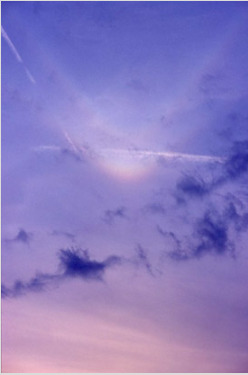Parry Arcs
Parry Arcs: A Fascinating Atmospheric Phenomenon
When it comes to atmospheric optics, Parry arcs are a captivating and often misunderstood phenomenon. These arcs exhibit a striking transformation in appearance as the elevation of the sun changes. With their resemblance to double halos, they can leave observers in awe of the beauty and complexity of our atmosphere.
Parry arcs are named after the British Arctic explorer, William Edward Parry, who first described them during his expeditions in the early 19th century. These arcs are formed by the refraction and reflection of sunlight through hexagonal ice crystals in the atmosphere. Unlike other atmospheric optical phenomena, Parry arcs are relatively rare and require specific conditions to occur.
The appearance of Parry arcs can vary depending on the elevation of the sun. At low sun elevations, they often resemble the upper tangent arc, creating the illusion of a double halo. As the sun rises higher in the sky, the Parry arc takes on a more distinct shape, appearing as a bright curve above the main halo.
To better understand Parry arcs, it is important to grasp the concept of refraction and reflection of light within ice crystals. When sunlight enters an ice crystal, it undergoes refraction, bending as it passes through the crystal. This bent light then reflects off the inside surface of the crystal before exiting at a different angle. The combination of these processes creates the unique optical effects observed in Parry arcs.
The shape and orientation of the ice crystals play a crucial role in determining the appearance of Parry arcs. These crystals are typically plate-like or column-like in shape, with flat faces that can act as mirrors for reflecting light. The orientation of these crystals in the atmosphere affects how sunlight interacts with them, resulting in the formation of various optical phenomena, including Parry arcs.
Parry arcs are most commonly observed in polar regions where ice crystals are abundant in the atmosphere. However, they can also occur in other locations under specific weather conditions. To witness this phenomenon, one must have a clear view of the sky and be positioned with the sun low on the horizon. Additionally, the presence of high-altitude cirrus clouds, composed of ice crystals, can enhance the visibility of Parry arcs.
It is important to note that Parry arcs are just one aspect of a broader family of atmospheric optical phenomena known as halos. These halos include other arcs, such as the circumzenithal arc and the upper tangent arc. Each of these arcs has its own unique characteristics and can be observed under different atmospheric conditions.
In conclusion, Parry arcs are a captivating atmospheric phenomenon that showcases the intricate interplay between sunlight and ice crystals in our atmosphere. Their appearance varies depending on the elevation of the sun, often resembling double halos at low sun elevations. To witness these awe-inspiring arcs, one must be in the right place at the right time, with a clear view of the sky and specific weather conditions. So next time you find yourself marveling at the beauty of a halo, take a moment to appreciate the complexity behind the formation of Parry arcs and the wonders of our atmosphere.

Parry and upper tangent arcs at low sun. Captured by Gerd Pfeiffer at Konz, Germany on 8th April at 19.50 CEST, sun elevation 3.5�.
Parry arcs change dramatically in appearance as the sun elevation changes. Here the sunvex Parry arc, the uppermost arc, closely resembles the tangent arc just beneath it giving the appearance of a double halo.
Image �Gerd Pfeiffer, used with permission.
Note: this article has been automatically converted from the old site and may not appear as intended. You can find the original article here.
Reference Atmospheric Optics
If you use any of the definitions, information, or data presented on Atmospheric Optics, please copy the link or reference below to properly credit us as the reference source. Thank you!
-
<a href="https://atoptics.co.uk/blog/parry-arcs-4/">Parry Arcs </a>
-
"Parry Arcs ". Atmospheric Optics. Accessed on November 26, 2024. https://atoptics.co.uk/blog/parry-arcs-4/.
-
"Parry Arcs ". Atmospheric Optics, https://atoptics.co.uk/blog/parry-arcs-4/. Accessed 26 November, 2024
-
Parry Arcs . Atmospheric Optics. Retrieved from https://atoptics.co.uk/blog/parry-arcs-4/.